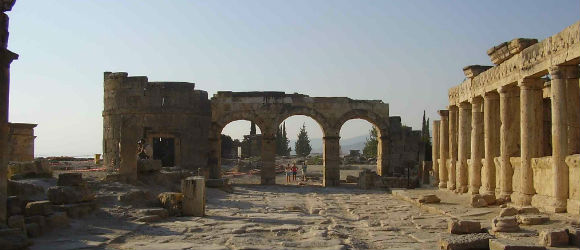The presence of a hot spring at Hierapolis and the spectacular calcium deposits from its water spilling over the nearby hillside suggest that there should be evidence of an early settlement there. The oldest Inscription found so far, however, indicates it was founded by Eumenes II, king of Pergamon, in the latter part of the second century B.C.; it soon became a busy industrial center.
Pagan worship in the city centered around Cybele, Apollo, Artemis, Men, Poseidon, and Pluto. Underneath the Temple of Apollo has been found the Plutonium, an opening in the earth from which a noxious gas still comes. The temple is between the pool where the hot spring rises and the large theater on the side of the hill. To the north along the rim of the plateau is a long avenue of tombs.
Traditionally St. Philip is connected with the early church in Hierapolis. Fairly recently Italian archeologlsts have discovered his Martyrium, an octagonal chamber forming a double cross surrounded by a square. This is almost due north of the theater, also on the side of the hill. It was a fifth century A.D. building and did not last much more than 100 years. No tomb was found with it although that was expected. There are several ruins of churches, one not far from the baths, one on the main road leading to the necropolis.
Hierapolis is listed in the New Testament along with Laodicea as the center of Epaphras’s work (Colos-sians 4:13). This was at the time Paul was writing to strengthen the message Epaphras was preaching and to condemn the “people who go in for self-mortification and angel-worship” (Colossians 2:18). Another less well-known resident of Hierapolis was Papias, a disciple of St. John and the author of the lost book called the Sayings of Jesus.
While Epaphras was is that area, a young slave was growing up in Hierapolis, a boy whose original name is unknown but whom we call by the Greek for “Acquired”, Epictetus. In his Discourses Epictetus often talks about the perfect missionary whose bed was the ground, whose only house the earth and sky and a shabby cloak, and who must love those who misuse him in the service of God. One wonders what the influence of those early Christians, many of whom were slaves themselves, was on this Stoic philosopher.
Hierapolis,


If you are travelling to Turkey for vacations, include Pamukkale and Antalya in your trip for sure.
if you are interested in history, this will be your mecca – if you are not interested in history, you will be fascinated by the sights and will freak out for the calcium pools.
experience Hierapolis on foot only, and if too tired…
Breathtaking travertines made my holiday in Turkey. Cleopatra pool was overcrowded and im not if it was worth going there. Ruins were interesting too. Place definitely worth to visit
Pamukale is known as the cotton castle. It does look like one at the distance. However, some of the travertines seem to have been suffering from the touristic activity. In fact, part of it is closed to the public. As incredible as if feels walking on the steep mountain, the authorities should really take better care of this World Heritage…
We went on a 2 day excursion to Ephesus and Pamukkale. Pamukkale exceeded our expectations and all the photos we took just don't do it justice. We had 2 hours free time which was spent walking barefoot down this amazing calcium waterfall feature and experience the warm to hot water rushing down over the walk way. It was also in…
The whole area takes approximately 2-3 hrs to cover various temples, theaters and pools. Some areas still have the structures remaining than the others. A location in a wide open field which makes it a very nice walk in a mild weather.
This is one of the few times when sightseeing that you can have a "two-fer". Both Pamukkale and Hierapolis share adjacent locations and, unless you really have to examine every square inch of both sites, are both easily seen in a half-day. Mornings are preferable before hordes of German, Russian and Japanese tour buses descend on the area in the…
You will never be able to walk in the ruins or swim in a roman bath like this one.
Loved it! Was a little disappointed with the Cleopatra Bath as it just seemed to be a big pool but everything else was great. Walking around the ruins was wonderful and its probably best to go later in the day or early as the afternoon was just too hot!
We spent a day here during a recent trip to Turkey. We enjoyed touring the ancient city but it is quite spread out and requires a lot of climbing and walking. Take water with you for your tour. The amphitheater is worth the hike and the monuments in necropolis are well preserved. The city is next to the Pamulkke thermal…
Cool place to visit with ruins and a calcium springs that cause amazing white deposits to solidify over the sides of the mountain. It feels very touristy due to the many bathers as well as those there to visit the ruins. Must see if in the area.